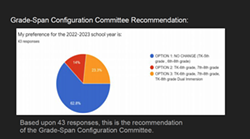Paso Robles Joint Unified School District discussed the results of its grade-span configuration committee recommendations that could change the grade levels in elementary and middle schools. The resounding preference to keep the grade span as is, staff said, is a sign of wanting stability after the challenges of the pandemic.
Grade span configuration refers to the range of grades within a school. Paso's current model district-wide is transitional kindergarten (TK) through fifth grade in one school and sixth through eighth grade in another.

- IMAGE COURTESY OF PASO ROBLES JOINT UNIFIED SCHOOL DISTRICT
- MAJORITY RULES Paso Robles Joint Unified School District will keep its current grade-span configuration of TK through fifth grade and sixth through eighth grade campuses.
The district started talking about what changes to the grade span were possible pre-pandemic and established a committee spearheaded by Curriculum and Instruction Director Erin Haley that included teachers and classified staff and incorporated parent input. The committee had five meetings from April to June 2021 to gather input, research, discuss, and conduct surveys on three options.
The options included keeping the current grade-span configuration, changing it to transitional kindergarten through sixth grade for elementary and seventh to eighth grade for middle school, or transitional kindergarten through sixth grade/seventh to eighth grade/TK through eighth grade dual immersion.
Ultimately of the 53 committee members—except for 10 members who didn't want to participate in the survey—nearly 63 percent voted in favor of sticking with the current grade span, while 23 percent voted for option two, and 14 percent voted for option three.
Haley said she believes the survey results are a sign of the current state in which teachers, parents, and students find themselves.
"If we weren't coming out of COVID-19 right now, I think this data would be different. We have teachers and staff who are seeking stability and consistency, and what I think this represents," she said. "They want to catch their breath without something new."
The challenges of the current model include the difficulties that students have transitioning from elementary to middle school.
The benefits of option two and three are less crowded middle school sites, specialized after-school programming, and a longer support system for English-Learners in the dual immersion transitional kindergarten through eighth grade option. The common downsides to both options are low levels of parent involvement, conflicting lunch scheduling, and one impacted middle school site.
More than 320 TK through fifth grade parents were surveyed and 38 percent voted to refrain from change, 33 percent voted for option two, and nearly 30 percent voted for option three. Of 223 sixth through 12th grade parents gave their preference, 48 percent preferred to keep the grade span as is, 30 percent grade span voted for option two, and 21 percent voted for option three.
Instead of changing the grade span, staff will support sixth graders with a new program in the fall called Where Everybody Belongs (WEB). Teachers will lead the program and students will be paired with a seventh- or eighth-grader who they can meet up with once a month or more to talk and ask questions.
The school board accepted the committee recommendations but did not give staff further direction because they felt the presentation lacked information on how a change in grade span could impact students' academic performance. Δ
Comments